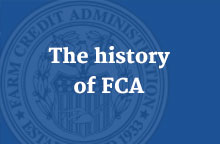Description of FCS institution types
Agricultural credit association (ACA)
An ACA is the result of the merger of a federal land bank association or a federal land credit association and a production credit association and has the combined authority of the two institutions. An ACA obtains funds from a farm credit bank or an agricultural credit bank to provide short-, intermediate-, and long-term credit to farmers, ranchers, producers and harvesters of aquatic products, and to rural residents for housing. An ACA also makes loans to these borrowers for basic processing and marketing activities, and to farm-related businesses. All ACAs operate with a parent-subsidiary structure, with the ACA as the parent and a wholly owned production credit association and federal land credit association as subsidiaries.
Agricultural credit bank (ACB)
An ACB is the result of the merger of a farm credit bank and a bank for cooperatives and has the combined authorities of those two institutions. Using its authorities as an FCB, an ACB provides services and funds to local associations that, in turn, lend those funds to farmers, ranchers, producers and harvesters of aquatic products, rural residents for housing, and farm-related businesses. Using its authorities as a bank for cooperatives, an ACB provides lending and other financial services to farmer-owned cooperatives, rural utilities (electric and telephone), and rural sewer and water systems. In addition, an ACB is authorized to finance U.S. agricultural exports and provide international banking services for farmer-owned cooperatives. CoBank, ACB, is the only ACB in the FCS.
Bank for cooperatives (BC)
A BC provides lending and other financial services to farmer-owned cooperatives, rural utilities (electric and telephone), and rural sewer and water systems. A BC is also authorized to finance U.S. agricultural exports and provide international banking services for farmer-owned cooperatives. The last standalone BC in the FCS, the St. Paul Bank for Cooperatives, merged into CoBank, ACB, on July 1, 1999.
Farm credit bank (FCB)
FCBs were created on July 6, 1988, in 11 of the 12 then-existing FCS districts when the federal land bank and federal intermediate credit bank in each district merged. The mergers were required by the Agricultural Credit Act of 1987. FCBs provide services and funds to local associations that, in turn, lend those funds to farmers, ranchers, producers and harvesters of aquatic products, rural residents for housing, and certain farm-related businesses. Since 1988, mergers between FCBs have reduced their number to four.
FCS Financial Assistance Corporation
Created by the Agricultural Credit Act of 1987 and chartered in 1988, the Assistance Corporation provided capital to the FCS by purchasing preferred stock from FCS institutions that received financial assistance authorized by the FCS Assistance Board. The Assistance Corporation provided approximately $1.26 billion before its authority to raise additional funds expired on December 31, 1992.
Following statutory requirements, the Assistance Corporation repaid its obligations in June 2005 and received a final audit in September 2005. After determining that the Assistance Corporation had completed its statutory mission, complied with applicable laws and regulations, and operated in a safe and sound manner, the FCA board canceled the charter of the Assistance Corporation as of December 31, 2006.
Federal intermediate credit bank (FICB)
The Agricultural Credits Act of 1923 provided for the creation of 12 FICBs to discount farmers’ short- and intermediate-term notes made by commercial banks, livestock loan companies, thrift institutions, and, beginning in 1933, production credit associations. On July 6, 1988, 11 of the 12 then-existing FICBs merged with the federal land banks in their respective districts to form farm credit banks. The mergers were required by the Agricultural Credit Act of 1987. The last remaining FICB, the FICB of Jackson, merged with the FCB of Columbia, which was renamed AgFirst Farm Credit Bank on October 1, 1993.
Federal land bank (FLB)
The Federal Farm Loan Act of 1916 provided for the establishment of 12 FLBs to provide long-term mortgage credit to farmers and ranchers, and later to rural homebuyers. On May 20, 1988, the FLB of Jackson was placed in receivership and liquidated. On July 6, 1988, the 11 remaining FLBs merged with the federal intermediate credit banks in their respective districts to form farm credit banks. The mergers were required by the Agricultural Credit Act of 1987.
Federal land bank association (FLBA)
An FLBA was a lending agent for a federal land bank and later the farm credit bank and the agricultural credit bank. FLBAs originated and serviced long-term mortgage loans to farmers and ranchers, and to rural residents for housing. FLBAs did not own the loan assets but originated loans on behalf of the federal land banks/FCS banks with which they were affiliated. As of October 1, 2000, there are no longer any FLBAs in the FCS. They either merged with production credit associations to form ACAs or became direct-lender federal land credit associations when farm credit banks transferred their authority to make long-term mortgage loans to their affiliated FLBAs.
Federal land credit association (FLCA)
The Agricultural Credit Act of 1987 authorized an FCS bank to transfer its direct-lending authority for long-term mortgage loans to a federal land bank association. These associations are designated as FLCAs. Unlike a federal land bank association, an FLCA owns its loan assets. An FLCA obtains funds from an FCS bank to make and service long-term mortgage loans to farmers and ranchers, and to rural residents for housing. An FLCA also makes loans to these borrowers for basic processing and marketing activities, and to farm-related businesses. Most present-day FLCAs are now subsidiaries of ACAs.
Production credit association (PCA)
The Farm Credit Act of 1933 authorized farmers to organize PCAs to deliver short- and intermediate-term loans to farmers and ranchers, and to rural residents for housing. A PCA also makes loans to these borrowers for basic processing and marketing activities, and to farm-related businesses. A PCA obtains funds from an FCS bank to lend to its members. PCAs own their loan assets. All present-day PCAs are now subsidiaries of ACAs.



